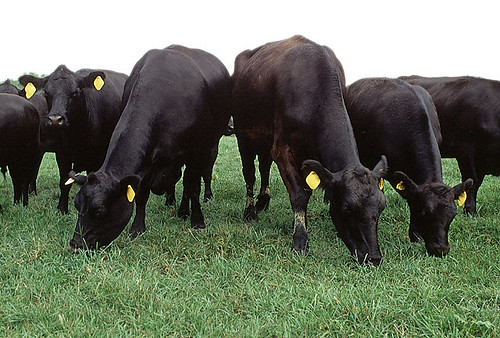What is grass-fed beef?
Some purists consider that grass-fed means only animals which “have have eaten nothing but their mother’s milk and fresh grass or grass-type hay from birth to harvest—all their lives.” Technically, this is a bunch of bunk and impossible to achieve.Reason being is that there are seeds, legumes, tree leaves, even small shrubs that cows need to eat to keep their bodies in balance. A pure grass diet would actually make them a bit sick. But cows eat a wide variety of forage to keep themselves healthy. They do this because they have a four-chambered stomach and so re-digest it until all the nutrients they can use are extracted.
Any healthy pasture you look at has a thousand or more different varieties of plants growing there, and not all of them are really grass.
The best, most environmentally responsible grazing (called mob grazing) will actually have them eating stalks that have grown up and gone to seed. So it's not some academic issue phrased by government dictocrats. Cows eat a lot of varieties of stuff to make your beef. And that's what gives it real flavor.
Which then brings up the problems that grain-finished cattle producers have – a pure grain diet changes the body chemistry of cattle and makes them put on extra fat, which causes all sorts of problems for us human consumers (as well as the cattle.) Since our corn has similarly been commoditized to be always yellow and 1/3 of the possible protein geneticized out of it, it's mostly tasteless starch - which to us would be similar to having a diet of Twinkies. Sure, we put on extra fat and gain weight. That's what a grain-fed diet is supposed to do.
The bulk of our meat in grocery stores and local markets and restaurants are grain-fed beef. The problems with this is that it is fairly tasteless and a steady diet of it would not help your heart much. Too much fat, too little of the good vitamins people need.
And the current trend is to get back to more traditional methods of raising beef – which is just on grassy pastures. Of course in the winter, unless you make other preparations, you'll be feeding them hay - which is just grass dried up and compressed into big rolls or squares and kept out of the weather so it doesn't decay.
Environmental and health benefits of grass-fed beef
To be most environmentally responsible, it make far more sense to raise animals on pasture. High quality, healthy pastures reduce soil erosion, improve water quality (a University of Wisconsin study showed that pastures are the “best” crop for reducing runoff and erosion), increase plant diversity, and provide high quality wildlife habitat. Properly managed, grazing cattle will actually improve the quality of the pasture in both quantity of forage and diversity.Grass-fed meats are associated with a variety of health benefits as well. It is leaner and lower in fat and calories ounce for ounce than grain-fed beef.
Additionally, studies have shown that grass-fed meat contains more of vitamins A and E, conjugated linoleic acids (CLA), and omega-3 fatty acids, all of which have been shown to lower cholesterol and high blood pressure, and decrease the risk of diabetes and cancer.
Nutrition information for grass-fed beef: Galloway beef nutrient content comparison to other cooked meats, three ounces, trimmed
- pasture-finished Galloway beef loin
USDA Prime Grade beef loin
USDA Choice Grade beef loin
Pork loin
Lamb loin
Chicken breast without skin
Chicken thigh without skin
Protein (grams) | 27 | 24 | 24 | 26 | 26 | 26 | 22 |
Fat (grams) | 3.5 | 11.6 | 8.7 | 6.6 | 8.2 | 1.3 | 7.0 |
Calories | 129 | 201 | 175 | 165 | 176 | 119 | 151 |
And Grass Fed Beef has real taste
A pasture-based diet directly affects meat flavor. It changes the fatty acid content of meat. Grass-fed meats are often described as more intensely flavored. And this changes your approach to cooking this meat, as it requires far less additives to make it tasty. It already is tasty..The other points affecting beef flavor are age (how old the animal is) and stress at slaughter (when the animal is shipped to a remote location, it is often excited and releases hormones into the muscle). Many locally-raised beef producers will have the animal slaughtered on site and then processed at a locker nearby to avoid that stress. And older animals, even when made into hamburger, are still far more flavorful than their corn-finished cousins.
(My old standby is to tell someone to take an average fast-food burger with everything on it, then take out the patty and eat the rest. Usually, there is no difference in taste, just slightly softer in texture.)
Another action taken with most pasture-finished natural beef is to “dry-age” it for 3-4 weeks, allowing the natural enzymes to break down the tissues and make the beef more tender. (Commercial grain-fed beef is “aged” only the amount of time it takes to ship it cross-country to its destination.)
- - - -
While I raise my own grass-fed beef here in Missouri, I suggest you try a vendor such as La Cense Beef
(Thanks to the University of Wisconsin, "A Consumer's Guide to Grass-Fed Beef" Bulletin A3862 http://www.uwex.edu/ces/cty)


No comments:
Post a Comment